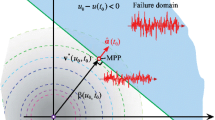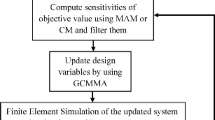Abstract
The use of topology optimization in structural design under dynamic excitation is becoming more prevalent in the literature. While many such applications utilize frequency or time domain formulations, relatively few consider stochastic dynamic excitations. This paper presents an efficient and compact code called TopSTO for structural topology optimization considering stationary stochastic dynamic loading using a method derived from random vibration theory. The theory, described in conjunction with the implementation in the provided code, is illustrated for a seismically excited building. This work demonstrates the efficiency of the approach in terms of both the computational resources and minimal amount of code required. This code is intended to serve as a baseline for understanding the theory and implementation of this topology optimization approach and as a foundation for additional applications and developments.
Similar content being viewed by others
References
Andreassen E, Clausen A, Schevenels M, Lazarov BS, and Sigmund O (2011), “Efficient Topology Optimization in MATLAB Using 88 Lines of Code,” Structural and Multidisciplinary Optimization, 43(1): 1–16. https://doi.org/10.1007/s00158-010-0594-7
Angelucci G, Quaranta G and Mollaioli F (2022), “Topology Optimization of Multi-Story Buildings Under Fully Non-Stationary Stochastic Seismic Ground Motion,” Structural and Multidisciplinary Optimization, 65(8): 217. https://doi.org/10.1007/s00158-022-03319-5
Arora JS (2011), Introduction to Optimum Design (3rd ed), Boston: Academic Press, USA.
Behrou R and Guest JK (2017), “Topology Optimization for Transient Response of Structures Subjected to Dynamic Loads,” 18th AIAA/ISSMO Multidisciplinary Analysis and Optimization Conference, Denver, Colorado, USA. https://doi.org/10.2514/6.2017-3657
Bendsøe MP (1995), Optimization of Structural Topology, Shape, and Material,” Springer Berlin Heidelberg, Germany. https://doi.org/10.1007/978-3-662-03115-5
Bendsøe MP and Kikuchi N (1988), “Generating Optimal Topologies in Structural Design Using a Homogenization Method,” Computer Methods in Applied Mechanics and Engineering, 71(2): 197–224. https://doi.org/10.1016/0045-7825(88)90086-2
Bendsøe MP and Sigmund O (1999), “Material Interpolation Schemes in Topology Optimization,” Archive of Applied Mechanics (Ingenieur Archiv), 69(9-10): 635–654. https://doi.org/10.1007/s004190050248
Clough RW and Penzien J (1975), Dynamics of Structures, McGraw–Hill, USA.
Craig RR and Kurdila A (2006), Fundamentals of Structural Dynamics (2nd ed), John Wiley, USA.
Díaz A and Sigmund O (1995), “Checkerboard Patterns in Layout Optimization,” Structural Optimization, 10(1): 40–45. https://doi.org/10.1007/BF01743693
Du J and Olhoff N (2007), “Topological Design of Freely Vibrating Continuum Structures for Maximum Values of Simple and Multiple Eigenfrequencies and Frequency Gaps,” Structural and Multidisciplinary Optimization, 34(2): 91–110. https://doi.org/10.1007/s00158-007-0101-y
Ferrari F and Sigmund O (2020), “A New Generation 99 Line Matlab Code for Compliance Topology Optimization and Its Extension to 3D,” Structural and Multidisciplinary Optimization, 62(4): 2211–2228. https://doi.org/10.1007/s00158-020-02629-w
Ferrari F, Sigmund O and Guest JK (2021), “Topology Optimization with Linearized Buckling Criteria in 250 Lines of Matlab,” Structural and Multidisciplinary Optimization, 63(6): 3045–3066. https://doi.org/10.1007/s00158-021-02854-x
Fox RL and Kapoor MP (1968), “Rates of Change of Eigenvalues and Eigenvectors,” AIAA Journal, 6(12): 2426–2429. https://doi.org/10.2514/3.5008
Giraldo-Londoño O and Paulino GH (2021a), “PolyDyna: A Matlab Implementation for Topology Optimization of Structures Subjected to Dynamic Loads,” Structural and Multidisciplinary Optimization, 64(2): 957–990. https://doi.org/10.1007/s00158-021-02859-6
Giraldo-Londoño O and Paulino GH (2021b), “PolyStress: A Matlab Implementation for Local Stress-Constrained Topology Optimization Using the Augmented Lagrangian Method,” Structural and Multidisciplinary Optimization, 63(4): 2065–2097. https://doi.org/10.1007/s00158-020-02760-8
Golecki T, Gomez F, Carrion J and Spencer BF (2022), “Continuous Random Field Representation of Stochastic Moving Loads,” Probabilistic Engineering Mechanics, 68: 103230. https://doi.org/10.1016/j.probengmech.2022.103230
Golecki T, Gomez F, Carrion J and Spencer BF (2023), “Bridge Topology Optimization Considering Stochastic Moving Traffic,” Engineering Structures, 292: 116498. https://doi.org/10.1016/j.engstruct.2023.116498
Gomez F and Spencer BF (2019), “Topology Optimization Framework for Structures Subjected to Stationary Stochastic Dynamic Loads,” Structural and Multidisciplinary Optimization, 59(3): 813–833. https://doi.org/10.1007/s00158-018-2103-3
Gomez F, Spencer BF and Carrion J (2020), “Topology Optimization of Buildings Subjected to Stochastic Base Excitation,” Engineering Structures, 223: 111111. https://doi.org/10.1016/j.engstruct.2020.111111
Gomez F, Spencer BF and Carrion J (2021a), “Simultaneous Optimization of Topology and Supplemental Damping Distribution for Buildings Subjected to Stochastic Excitation,” Structural Control and Health Monitoring, 28(7): e2737. https://doi.org/10.1002/stc.2737
Gomez F, Spencer BF and Carrion J (2021b), “Topology Optimization of Buildings Subjected to Stochastic Wind Loads,” Probabilistic Engineering Mechanics, 64: 103127. https://doi.org/10.1016/j.probengmech.2021.103127
Guest JK, Prévost JH and Belytschko T (2004), “Achieving Minimum Length Scale in Topology Optimization Using Nodal Design Variables and Projection Functions,” International Journal for Numerical Methods in Engineering, 61(2): 238–254. https://doi.org/10.1002/nme.1064
Guyan RJ (1965), “Reduction of Stiffness and Mass Matrices,” AIAA Journal, 3(2): 380–380. https://doi.org/10.2514/3.2874
James KA, Hansen JS and Martins JRRA (2009), Structural Topology Optimization for Multiple Load Cases Using a Dynamic Aggregation Technique,” Engineering Optimization, 41(12): 1103–1118. https://doi.org/10.1080/03052150902926827
Jang HH, Lee HA, Lee JY and Park GJ (2012), “Dynamic Response Topology Optimization in the Time Domain Using Equivalent Static Loads,” AIAA Journal, 50(1): 226–234. https://doi.org/10.2514/1.J051256
Kanai K (1957), “210) Semi-Empirical Formula for the Seismic Characteristics of Ground (Structure),” Transactions of the Architectural Institute of Japan, 57.1: 281–284. (in Janpanese) https://doi.org/10.3130/aijsaxx.57.1.0_281
Kim NH, Dong T, Weinberg D and Dalidd J (2021), Generalized Optimality Criteria Method for Topology Optimization,” Applied Sciences, 11(7): 3175. https://doi.org/10.3390/app11073175
Liu H, Zhang W and Gao T (2015), “A Comparative Study of Dynamic Analysis Methods for Structural Topology Optimization Under Harmonic Force Excitations,” Structural and Multidisciplinary Optimization, 51(6): 1321–1333. https://doi.org/10.1007/s00158-014-1218-4
Liu K and Tovar A (2014), “An Efficient 3D Topology Optimization Code Written in Matlab,” Structural and Multidisciplinary Optimization, 50(6): 1175–1196. https://doi.org/10.1007/s00158-014-1107-x
Martin A and Deierlein GG (2020), “Structural Topology Optimization of Tall Buildings for Dynamic Seismic Excitation Using Modal Decomposition,” Engineering Structures, 216: 110717. https://doi.org/10.1016/j.engstruct.2020.110717
Pozo S, Golecki T, Gomez F, Carrion J and Spencer BF (2023), “Minimum-Thickness Method for 2.5D Topology Optimization Applied to Structural Design,” Engineering Structures, 286: 116065. https://doi.org/10.1016/j.engstruct.2023.116065
Sigmund O (2001), “A 99 Line Topology Optimization Code Written in Matlab,” Structural and Multidisciplinary Optimization, 21(2): 120–127. https://doi.org/10.1007/s001580050176
Sigmund O (2007), “Morphology-Based Black and White Filters for Topology Optimization,” Structural and Multidisciplinary Optimization, 33(4-5): 401–424. https://doi.org/10.1007/s00158-006-0087-x
Sigmund O (2022), “On Benchmarking and Good Scientifi c Practise in Topology Optimization,” Structural and Multidisciplinary Optimization, 65(11): 315. https://doi.org/10.1007/s00158-022-03427-2
Sigmund O and Petersson J (1998), “Numerical Instabilities in Topology Optimization: A Survey on Procedures Dealing with Checkerboards, Mesh-Dependencies and Local Minima,” Structural Optimization, 16(1): 68–75. https://doi.org/10.1007/BF01214002
Soong TT and Grigoriu M (1993), Random Vibration of Mechanical and Structural Systems, PTR Prentice Hall, USA.
Svanberg K (1987), “The Method of Moving Asymptotes—A New Method for Structural Optimization,” International Journal for Numerical Methods in Engineering, 24(2): 359–373. https://doi.org/10.1002/nme.1620240207
Talischi C, Paulino GH, Pereira A and Menezes IFM (2012), “PolyTop: A Matlab Implementation of a General Topology Optimization Framework Using Unstructured Polygonal Finite Element Meshes,” Structural and Multidisciplinary Optimization, 45(3): 329–357. https://doi.org/10.1007/s00158-011-0696-x
Tavakoli R (2014), “Multimaterial Topology Optimization by Volume Constrained Allen-Cahn System and Regularized Projected Steepest Descent Method,” Computer Methods in Applied Mechanics and Engineering, 276: 534–565. https://doi.org/10.1016/j.cma.2014.04.005
The MathWorks, Inc. (2022), MATLAB (9.12.0.1975300) [Win64], MathWorks, USA.
Wang C, Zhao Z, Zhou M, Sigmund O and Zhang XS (2021a), “A Comprehensive Review of Educational Articles on Structural and Multidisciplinary Optimization,” Structural and Multidisciplinary Optimization, 64(5): 2827–2880. https://doi.org/10.1007/s00158-021-03050-7
Wang L, Liu Y, Liu D and Wu Z (2021b), “A Novel Dynamic Reliability-Based Topology Optimization (DRBTO) Framework for Continuum Structures via Interval-Process Collocation and the First-Passage Theories,” Computer Methods in Applied Mechanics and Engineering, 386: 114107. https://doi.org/10.1016/j.cma.2021.114107
Wu J, Sigmund O and Groen JP (2021), “Topology Optimization of Multi-Scale Structures: A Review,” Structural and Multidisciplinary Optimization, 63(3): 1455–1480. https://doi.org/10.1007/s00158-021-02881-8
Yoo KS and Han SY (2013), “A Modified Ant Colony Optimization Algorithm for Dynamic Topology Optimization,” Computers and Structures, 123: 68–78. https://doi.org/10.1016/j.compstruc.2013.04.012
Zargham S, Ward TA, Ramli R and Badruddin IA (2016), “Topology Optimization: A Review for Structural Designs Under Vibration Problems,” Structural and Multidisciplinary Optimization, 53(6): 1157–1177. https://doi.org/10.1007/s00158-015-1370-5
Zhao J and Wang C (2016), “Dynamic Response Topology Optimization in the Time Domain Using Model Reduction Method,” Structural and Multidisciplinary Optimization, 53(1): 101–114. https://doi.org/10.1007/s00158-015-1328-7
Zheng J, Luo Z, Jiang C and Gao J (2019), “Robust Topology Optimization for Concurrent Design of Dynamic Structures Under Hybrid Uncertainties,” Mechanical Systems and Signal Processing, 120: 540–559. https://doi.org/10.1016/j.ymssp.2018.10.026
Zhu M, Yang Y, Guest JK and Shields MD (2017), “Topology Optimization for Linear Stationary Stochastic Dynamics: Applications to Frame Structures,” Structural Safety, 67: 116–131. https://doi.org/10.1016/j.strusafe.2017.04.004
Author information
Authors and Affiliations
Corresponding author
Rights and permissions
About this article
Cite this article
Pozo, S., Gomez, F., Golecki, T. et al. TopSTO: a 115-line code for topology optimization of structures under stationary stochastic dynamic loading. Earthq. Eng. Eng. Vib. 22, 1081–1100 (2023). https://doi.org/10.1007/s11803-023-2219-3
Received:
Accepted:
Published:
Issue Date:
DOI: https://doi.org/10.1007/s11803-023-2219-3




